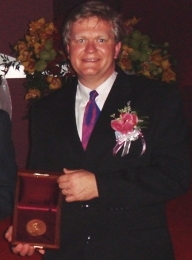Brian Schmidt
Brian P. Schmidt (born February 24, 1967) is a Distinguished Professor, Australian Research Council Laureate Fellow and astrophysicist at the Australian National University Mount Stromlo Observatory and Research School of Astronomy and Astrophysics. He is widely known for his research in using supernovae as Cosmological Probes. He currently holds an Australia Research Council Federation Fellowship. Schmidt shared both the 2006 Shaw Prize in Astronomy and the 2011 Nobel Prize in Physics with Saul Perlmutter and Adam Riess for providing evidence that the expansion of the universe is accelerating.
Brian P. Schmidt | |
|---|---|
 Brian Schmidt receiving the Shaw Prize for astronomy in 2006 (won jointly with Adam Riess and Saul Perlmutter) | |
| Born | February 24, 1967 Missoula, Montana, United States |
| Citizenship | Australia |
| Alma mater | University of Arizona (1989), Harvard University (1993) |
| Awards | Shaw Prize in Astronomy (2006) Nobel Prize in Physics (2011) |
| Scientific career | |
| Institutions | Australian National University |
| Doctoral advisor | Robert Kirshner |
| Notes | |
"FACTBOX-Nobel physics prize winners", Reuters News, 4 October 2011. | |

Early life and education
changeSchmidt, an only child, was born February 24, 1967 in the Montana mountains. His father, Dana C. Schmidt, was a fisheries biologist. When he was 13, his family moved to Anchorage, Alaska.[1][2]
Schmidt went to Bartlett High School in Anchorage, and graduated in 1985. He has said that he wanted to be a meteorologist "since I was about five-years-old" but "... I did some work at the US National Weather Service up in Anchorage and didn't enjoy it very much. It was less scientific, not as exciting as I thought it would be - there was a lot of routine. But I guess I was just a little naive about what being a meteorologist meant." He decided to study astronomy just before he started at university.[3] He was graduated BS(Physics), BS(Astronomy) from the University of Arizona in 1989.[4] He received his MA (1992) and then PhD from Harvard University in 1993.[5] Schmidt's PhD thesis was supervised by Robert Kirshner and used Type II Supernovae to measure the Hubble Constant.
At Harvard, he met his future wife, an Australian, Jenny Gordon who was studying for a PhD in economics. In 1994, he moved to Australia.[1][4]
Work
changeSchmidt was a Postdoctoral Fellow at the Harvard-Smithsonian Center for Astrophysics (1993-94) before moving to Mount Stromlo Observatory in the Australian Capital Territory in 1995.
Schmidt and Adam Riess led the High-z Supernova Search Team which found evidence that the Universe's expansion rate is now accelerating. They discovered this by looking at Type 1a Supernova.[6] The discovery was the opposite of the current theory that the expansion of the universe was slowing down. By studying the color shifts in the light from the supernova from Earth, they discovered that these billion-year old nova were still accelerating.[7] This result was also found about the same time by the Supernova Cosmology Project, led by Saul Perlmutter.[7] With two studies getting the same result scientists now accept the accelerating universe theory. New research is now trying to understand the nature of the universe, such as the existence of dark matter.[7] The discovery of the accelerating universe was named 'Breakthrough of the Year' by Science Magazine in 1998. Schmidt was jointly awarded the 2011 Nobel Prize in Physics along with Reiss and Perlmutter for their groundbreaking work.[7]
Schmidt is currently leading the SkyMapper telescope Project and the associated Southern Sky Survey.
Awards
changeSchmidt has received the Australian Governments Malcolm McIntosh Prize in 2000, Harvard University's Bok Prize in 2000, the Australian Academy of Science's Pawsey Medal Medal in 2001, and the Vainu Bappu Medal of the Astronomical Society of India in 2002. He was the Marc Aaronson Memorial Lecturer in 2005, and in 2006, he shared the Shaw Prize in Astronomy with Adam Riess and Saul Perlmutter.[8][9]
Schmidt and the other members of the High-Z Team (the set defined by the co-authors of Riess et al. 1998) shared the 2007 Gruber Cosmology Prize, a $500,000 award, with Saul Perlmutter of the Lawrence Berkeley National Laboratory and the Supernova Cosmology Project (the set defined by the co-authors of Perlmutter et al. 1999) for their discovery of the accelerating expansion of the universe.
Schmidt, along with Riess and Perlmutter, jointly won the 2011 Nobel Prize in Physics for their observations which led to the discovery of the accelerating Universe.[8]
Related pages
changeReferences
change- ↑ 1.0 1.1 "Restless experimenter", The Canberra Times, 6 April 2011, p 8.
- ↑ "FACTBOX-Nobel physics prize winners", Reuters News, 4 October 2011.
- ↑ "Star turn in global success", The Canberra Times, 1 July 2006, p B02.
- ↑ 4.0 4.1 "SCHMIDT, Brian" in Who's Who Live Archived 2019-10-17 at the Wayback Machine (Australia), Crown Content Pty Ltd accessed 4 October 2011.
- ↑ The Universe from Beginning to End, Pollock Memorial Lecture, April 2009, The University of Sydney accessed 5 October 2011.
- ↑ Cosmology ABC Catalyst segment on Cosmology, with Brian Schmidt, Ray Norris, & Lawrence Kraus
- ↑ 7.0 7.1 7.2 7.3 Palmer, Jason (2011-10-04). "Nobel physics prize honours accelerating Universe find". BBC. Retrieved 2011-10-05.
- ↑ 8.0 8.1 "Nobel physics prize honours accelerating Universe find". BBC News. October 4, 2011.
- ↑ http://www.abc.net.au/news/2011-10-04/australian-astrophysicist-wins-nobel-prize/3209216%7Ctitle= Australian Astrophysicist Wins Nobel Prize